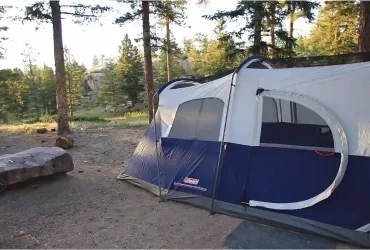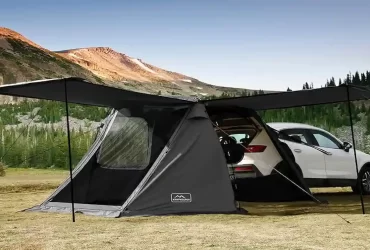Buying a tent for your family is like buying a car. Take into consideration the needs and wants of your family. To haul children and their gear in a vehicle, you will choose a minivan or SUV over a small, sporty car if you will be hauling children and their gear.
If you plan on backpacking, you must get the lightest and most durable tent that will still keep you safe from the elements. You could choose single tents for each camper and let him or her carry their own shelter.
It depends on where your tent will be pitched. A family camping tent is the best choice if you want adults and kids to be together while camping within a few yards of your pitch.
You should consider a tent with several mesh windows and vents. Mesh tents are generally made from nylon or polyester blended with mesh, in varying combinations according to the season.
Answering questions like these could help you determine if you’re more concerned about how easy the tent will be to pitch or how spacious it will be.
When you choose a tent, you should ensure that it will make camping a pleasure for your whole family, even if you use it only once a year. Let’s explore your options.
Considering the Following Factors
Dimensions

There are advertised tents for two, four, and six people. Nonetheless, there are most people you can fit into the tent for sleeping close together without personal gear. For backpackers who travel light, this rating method may make sense, but for all others, it may be absurd.
If you divide the advertised capacity of the tent by two, you will know its actual capacity. Thus, most tents designed for four people would be more suitable for two adults or two adults and two children.
Providing each person with a space of at least 30 square feet is recommended. On longer camping trips, take even more food, unless weight reduction is a priority.
The actual length and width play a significant role as well. The tent should be at least seven feet wide if you have people who are six feet tall, so that they can stretch out without bumping into the tent walls. Simply for sleeping, you will require at least two and one-half feet of width. A space of 17.5 square feet is required. Advertisements might specify that a tent measuring five by seven feet can hold two people.
The addition of a space to store clothing, as well as a space to stand up without stepping on your tentmate, will make the tent more comfortable. Tents for two people that are eight by eight feet are best suited for family camping. This means each person gets 32 square feet. This is not particularly generous.
The tent should be ten by ten feet to accommodate two adults. There will be room for cots or air mattresses, as well as a standing room for changing clothes.
Tents that are smaller can fit kids comfortably. Once they become old enough, they may want to sleep in a tent of their own. Providing parents with privacy will also be an advantage. Five by seven feet tents are sufficient for young children. Tents for teenagers should be fitted as if they were adults.
Do not use tents that are bigger than ten by ten feet. Three problems will arise. As a first step, you’ll need to find a level, smooth place big enough to set up the tent.
Make sure you choose a level spot. In addition, large tents can be quite heavy. The car will not have any problems with this, but think about how much work it would be for you to load and unload it. Lastly, are you really interested in sleeping and dressing in the same tent? There is a privacy issue with big tents.
For your comfort, the inside peak height is crucial. When going on most trips, make sure your tent is tall enough to stand in. Make sure you plan for taller people in the group. The height of the peak should be six or seven feet for adults, and four feet for kids. Tents slope downward sharply at an angle, so the standing area will be confined. Taller tents will provide a larger environment.
You may also like this:
Shape

Tents can be categorized into four types: A-frames, umbrellas, geodesic domes, and walls. In addition to being the most common tent shape for puppies, this shape can also be quite large. It’s common to use the umbrella tent for camping with your family, as it has a rain fly and plenty of standing room. It comes in many different shapes but looks like a series of connected together. In some ways, a wall tent resembles an A-frame tent, but is typically much bigger and has side walls.
Laying out sleeping arrangements and gear is more efficient in tents with square floors. Other factors may make it impossible to have a square floor in some cases. A geodesic dome tent has a round floor, or one that is nearly round, which requires some additional floor space to compensate for its less efficient layout.
Poles

Aluminum or fiberglass are commonly used for poles. There are poles on most tents that are connected with shock cords. This makes rigging the tent easier. In order to prevent poles from breaking or bending, many tent manufacturers provide emergency repair links for patrons to carry on-site.
Zippers

You should test zippers when shopping. The tent should be able to open and close freely without catching or binding up on the fabric. Metal zippers should not corrode.
You may also like this:
Seams
Reinforce seams by applying tape. To make the seams weatherproof, tape is used throughout. There is a need to waterproof nylon tent seams, both at the fly and at the floor. You should receive a bottle of seam sealer with your tent upon purchase. Put the tent up in the yard and seal it before you leave. You should dry the tent completely before packing it. The process will need to be repeated every year.
Climate Considerations

The demands placed on the tent by wind, rain, sun, heat, or cold are different. Strong poles, stakes, and anchor ropes are needed in windy areas. Wind-resistant geodesic tents are the best solution. Igloo-shaped structures reduce wind’s effect, while the pole arrangement enhances their strength.
The presence of rain creates two factors to consider. First, prevent the rain from coming in. The second thing is to provide enough space so that you will feel comfortable if you have to watch TV or play games indoors for a while during a storm.
The rainfly of your tent should be waterproof because it should be made from coated nylon. The fly should cover the entire tent and reach the ground on the sides. Windy weather won’t pose any problems in keeping rain out. If you open or close the door, the fly should extend as far over the door as possible to keep out any rain.
Nylon coated with a waterproof coating should also be used on the floor. Turn up the edges of the fabric for about six inches, and it should cover the floor. You should have a few seams in the fabric. The tub floor is called this. This keeps the water out from underneath the tent.
Heat and sun require shade and air circulation. An umbrella will provide shelter from the sun. A tent with large screened windows opposite a screened door will be able to allow air to flow through it.
The cold weather requires special attention. Unless you are dealing with snow, a three-season tent with good features is fine (in which case you would need a mountaineering tent). The tent will have two crucial components: a rain fly covering the top and sides, as well as an interior mesh layer, to permit water to pass through. Water vapor from damp fresh air and your exhalation will condense on a tent’s cooler external surface during cool weather. It is necessary to let the excess water vapor escape through the mesh fabric to prevent this from happening.
When camping in cold weather, it is also important to consider the tent size. The body heat will make a small tent warmer than the atmosphere outside. Nonetheless, some campers use tent heaters in their larger tents. A heater is not safe in a small tent due to the close proximity of the walls.
You may also like this:
Cost

More expensive tents tend to feature stronger fabrics, stronger poles, and stronger stitching. These tents will keep you dry and withstand heavier rains. There is no doubt that they will last for many years to come. You can expect a tent to last for a very long time if you choose the right one.
This level of strength and durability may not be necessary for everyone. The milder the weather and the closer you camp to home (“just in case”), the better bargains you will have with the least expensive tents.
You might want to stick with the cheapest tents if you are just starting out on your camping adventures with your family and aren’t sure whether you will enjoy them. A lot of families enjoy them. In order to gauge whether camping suits you, you will probably stay close to civilization during your first camping trip. Upgrade later to a better tent and keep your original budget tent until the weather permits.





Leave a Reply
View Comments